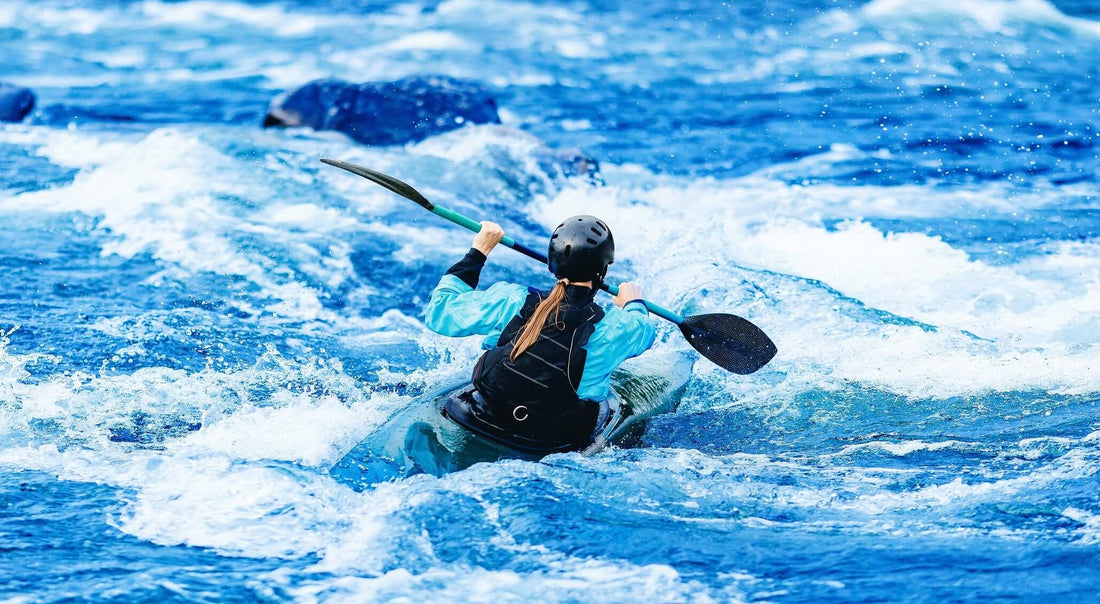Kayaking is such a versatile and accessible sport that more and more people are picking up the paddle. But before you take home your first kayak, you should think about what your kayaking dreams entail. Are you looking for a wild whitewater ride with speed and exhilarating waterfall drops or do you desire long stretches touring natural beauty and wildlife sightings? Deciding what you want to do in your kayak will help you make a more informed decision when it comes time to buy either a sea kayak or a whitewater kayak.
This article describes a few differences between a Sea Kayak and a Whitewater Kayak.
Sea Kayak Design
Sea Kayaks are designed to handle currents and waves with excellent tracking so that you can easily cover long distances. Sea kayaking is an endurance sport.
Function: Designed for the challenges of the ocean (waves, currents, winds)
Length: A longer boat is faster, tracks better, and stores more. Sea kayaks are made to go greater distances at good speed. They are also designed to track well. Having a nice straight ride is an advantage when you are on an expanse of water. They usually have ample storage: water-tight hatches and on-deck bungees.
Day touring sea kayak: 14-16 ft.
Expedition sea kayak: 16-18 ft.
Width: Sea kayaks are narrower than their counterparts. A narrow boat is usually considered less stable than its wider cousins. However, this is an advantage in a sea kayak as it will get tossed around less than a wide, stable platform. It will actually feel more stable when you are experiencing choppy conditions as it cuts through waves efficiently.
Width: 18-28 inches
Features:
- Double bulkheads: Sea kayaks are divided by bulkheads. This ensures that if the boat capsizes or takes on water, you don’t flood the whole boat. Just bail out the cockpit and the sealed compartments help to keep the craft afloat. In addition, those water-tight bulk heads can be used for storage. Sea kayaks are long enough to have two bulkheads (fore and aft) and sometimes more.
- Rudders / Skegs: Many sea kayaks employ rudders or skegs to more efficiently navigate the kayak. They help you stay on the straight and narrow during wind or high seas.
- Deck bungees: The sea kayak has more square footage available so there is usually a nice amount of deck storage. You can bungee down items that can get wet.
- Sit-in design: Sea kayaks are built in the traditional sit-in design. This means the kayak is a sealed hull with just a cockpit opening for sitting. A spray skirt can be attached to further prevent water from entering the kayak.
Whitewater Kayak Design
Function: Designed to charge hard over big rapids, drop over waterfalls, maneuver in tight spaces, and go around / over many obstacles and hazards. Whitewater kayaking is an adrenaline sport.
Length: A whitewater kayak is a short kayak which makes it much more maneuverable. Paddlers can shift the entire kayak with their body weight, push off with paddles, and generally use their kayak as an extension of themselves.
Creek boats & river runners: 7-9 ft
Playboats: 6 ft.
Width: While whitewater kayaks are generally a bit wider than their sea kayaking cousins, they aren’t as wide as some other kayaks. They are still created to be small and quick to respond to rapids and hazards.
Width: 22-28 inches
Features:
- Rockers: Whitewater kayaks have more rocker. Rocker is the curve of the boat from bow to stern. Whitewater craft will have a more extreme rocker - it will look more like a banana, as this allows the kayak to ride over large waves and makes it harder to swamp.
- Sit-in: Like their sea kayak brethren, whitewater kayaks are sit-in affairs. This design allows the paddler to have more control over the kayak and keeps water out, especially during drops and churn that can send lots of water at the ‘yak.
- Durable material: The extreme nature of this sport requires durable materials. Whitewater kayaks should be built to withstand hard bumps, drops, and rapids.
In summary, sea kayaks and whitewater kayaks serve distinct purposes in the realm of paddling. Sea kayaks are designed for open water exploration, offering stability, speed, and storage for extended journeys on the ocean / sea or a large lake. By contrast, whitewater kayaks are crafted for navigating fast-flowing rivers and rapids, prioritizing maneuverability and agility to handle turbulent waters and obstacles. Both types of kayaks cater to specific aquatic environments and activities, showcasing the diversity within the world of kayaking and providing enthusiasts with specialized tools for whatever your chosen water adventure is. Happy Paddling!

